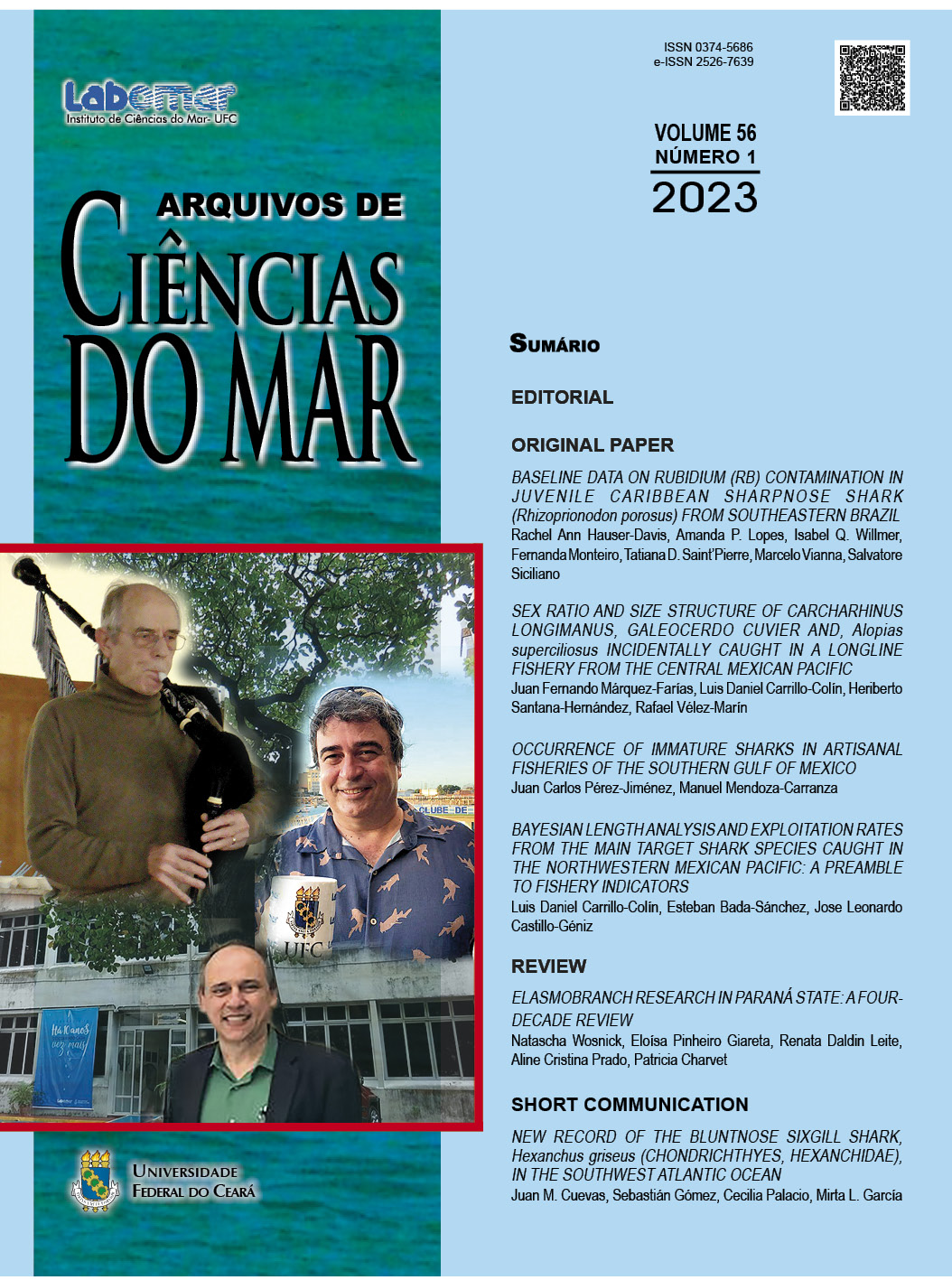SEX RATIO AND SIZE STRUCTURE OF Carcharhinus longimanus, Galeocerdo cuvier AND, Alopias superciliosus INCIDENTALLY CAUGHT IN A LONGLINE FISHERY FROM THE CENTRAL MEXICAN PACIFIC
Proporção sexual e estrutura de comprimento e peso de Carcharhinus longimanus, Galeocerdo cuvier e Alopias superciliosus capturados incidentalmente em uma pescaria de espinhel do Pacífico central mexicano
DOI:
https://doi.org/10.32360/acmar.v56i1.82913Resumen
Knowledge of life history and fish reproduction is essential to understand the population dynamics of exploited shark populations. We provide information regarding the length, weight, and sex ratio of Carcharhinus longimanus (oceanic whitetip shark), Galeocerdo cuvier (tiger sharks), and Alopias superciliosus (bigeye thresher sharks) from longline boats based on Manzanillo (39–45 m longline vessels), Colima, Mexico, from 1986 to 2001. We analyzed a total of 264 oceanic whitetip sharks with 107 females (86-186 cm FL) and 157 males (68-184 cm FL); 67 tiger sharks with 36 females (105-193 cm FL) and 31 males (103-207 cm FL) and 67 bigeye thresher sharks with 22 females (131-209 cm FL) and 45 males (138-204 cm FL). The sex ratio for the whole sample differed significantly from the expected 1:1 in the oceanic whitetip shark and bigeye thresher shark, probably due to the mobility nature of the species. The length-frequency distribution of the bigeye thresher shark revealed a high frequency of individuals of large size in the catches. This shark is, on average, larger and heavier than the oceanic whitetip shark and the tiger shark. Factors affecting the catch susceptibility of this particular group of species and their lengths (or ages) are discussed.
Keywords: Length-frequency, life history, Mexican Pacific, pelagic sharks
Descargas
Descargas
Publicado
Cómo citar
Número
Sección
Licencia
1. Proposta de Política para Periódicos de Acesso Livre
Autores que publicam nesta revista concordam com os seguintes termos:
- Autores mantém os direitos autorais e concedem à revista o direito de primeira publicação, com o trabalho simultaneamente licenciado sob a Licença Creative Commons Attribution que permite o compartilhamento do trabalho com reconhecimento da autoria e publicação inicial nesta revista.
- Autores têm autorização para assumir contratos adicionais separadamente, para distribuição não-exclusiva da versão do trabalho publicada nesta revista (ex.: publicar em repositório institucional ou como capítulo de livro), com reconhecimento de autoria e publicação inicial nesta revista.
- Autores têm permissão e são estimulados a publicar e distribuir seu trabalho online (ex.: em repositórios institucionais ou na sua página pessoal) a qualquer ponto antes ou durante o processo editorial, já que isso pode gerar alterações produtivas, bem como aumentar o impacto e a citação do trabalho publicado (Veja O Efeito do Acesso Livre).

